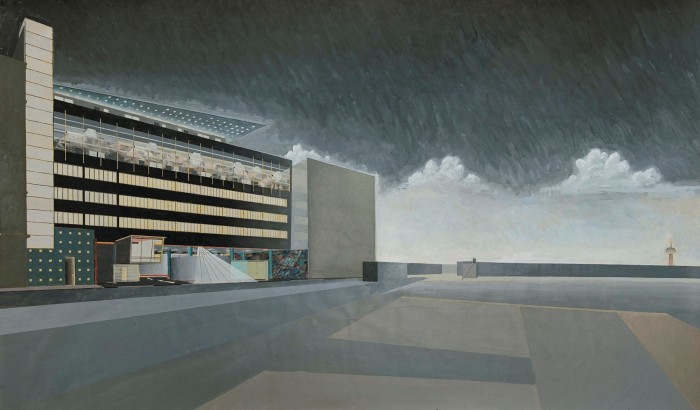Zoe Zenghelis: a painter whose medium is architecture

Roula Khalaf, Editor of the FT, selects her favourite stories in this weekly newsletter.
Modern architecture began as painting. Ideas were always and inevitably ahead of reality and the medium through which Modernism emerged was the painted canvas. From the strange, geometric surrealism of the Bauhaus and the vivid constructivism of Farkas Molnár’s Red Cube (1923) to the extravagant Suprematism of Ivan Leonidov and the industrial sublime of Yakov Chernikhov, the architecture of the early 20th century was first defined on the easel.
You might say the same about the architecture of the late 20th century too. Painting has proved to be a vivid and oddly enduring medium for communicating construction. You can see the relationship between the two at a small but captivating show of the work of Zoe Zenghelis at the Betts Project in London (currently online only but reopening when Covid restrictions are eased, and due to transfer in an expanded version to the Architectural Association later this month).
Zenghelis was there at the birth of OMA, the Office for Metropolitan Architecture, co-founded with her husband Elia Zenghelis, Rem Koolhaas and Madelon Vriesendorp in the mid 1970s. The new practice’s ideas were concretised in Koolhaas’s hugely influential and provocative 1978 book Delirious New York, a brilliant blend of history, technology, narrative and a reimagining of a city then struggling with bankruptcy and depopulation.

Although the words were electrifying, the images which stuck so stubbornly in the imagination were by Vriesendorp and Zoe Zenghelis. There were surreal landscapes of buildings as objets d’art, flaccid skyscrapers and anthropomorphised towers, tombstone-like blocks in endless grids and suggestions of megalomanic schemes reduced to a single city block like toytown utopias.
Look around the exhibition Zoe Zenghelis: Do you remember how perfect everything was?, curated by Hamed Khosravi, and you can see those ideas condensed into compelling, dreamlike suggestions of possible cities and impossible constructions.
Zenghelis, who was born in Athens in 1937, studied in London but found herself disillusioned with strictures of both interior and production design. The fanatical reproduction of an exact historic moment on stage failed to stimulate her, so she returned to painting. Yet she found herself working in architecture again with the foundation of OMA.
The practice’s early works were all theoretical projects, paper architecture, provocations rather than proposals. “The Hotel Sphinx” (1978) for instance, exhibited here in a dazzling grid and tower, envisaged a New York building with the attributes of the heterogeneous city, a cocktail of uses from luxury hotel and pool to social housing and civic infrastructure. The intention was to develop a new type of architecture for Times Square, an area which already embodied all these activities albeit incoherently and reluctantly.

At a smaller scale, there are evocative, Constructivist designs for her own house which seem to return to her stage-set student days with a Cubist-inspired interior that is stagy and strange in equal measure. When I speak to Zenghelis on the phone, she tells me that before it began building, OMA was sustained not only by teaching but by the sale of paintings. There are now examples in MoMA and dozens of other institutions and collections. “Once OMA started building, they dumped the painters,” she says with a self-deprecating giggle.
OMA was joined briefly in its early history by Zaha Hadid, who also found her expression in painting. In Zenghelis’s more angular and fragmented paintings you can absolutely see where Hadid drew her influence from, and she too would make her name in painting, with striking canvases that recalled Soviet Constructivist space. You can see too how Zenghelis’s own work was influenced by the Freudian dreamscapes of Vriesendorp, who always humanised buildings, introducing a surreal, cartoonish quality into the metropolis — the city as urban playground.

Crowded on to one wall, academy-style, is a lifetime of work, a line passing through towers and tombs, trees and cubist landscapes, but the thread that ties them all together is architecture, a certain type of tectonic representation. Pastel superblocks collide with deep shadows cast by looming wedges, towers appear as subsiding gravestones, buildings are scattered like disruptive pebbles on a sandy beach and walls are draped like curtains. The types of architecture contribute to a mood: melancholy, angst, playfulness, ecstasy and ennui through form, colour and distribution.
Zenghelis tells me she always saw herself as a painter, yet her medium is architecture; the concerns about objects in space, the grid, fragmentation and mass have remained remarkably consistent. The works on show here span the whole of Modernist history and historiography, from early experiments in reductive form to the rediscovery of Modernism as a visionary medium in itself, one which had at its heart the building of a new post-capitalist society.
Architects who think they are artists quickly become a problem, mistaking buildings for sculpture and producing unusable and overblown structures. But artists who work with architecture are a very different proposition: less destructive, more contemplative, capable of creating something closer to beauty. This is an engaging and engrossing little show from exactly one such artist.
3D virtual viewing room available now, bettsproject.com
Comments